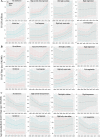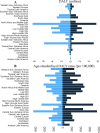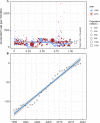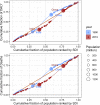Persistence of severe global inequalities in the burden of Hypertension Heart Disease from 1990 to 2019: findings from the global burden of disease study 2019
- PMID: 38184560
- PMCID: PMC10771693
- DOI: 10.1186/s12889-023-17573-9
Persistence of severe global inequalities in the burden of Hypertension Heart Disease from 1990 to 2019: findings from the global burden of disease study 2019
Abstract
Aims: Assessing the global burden and health inequalities of Hypertension Heart Disease (HHD) during the period from 1990 to 2019.
Methods: Secondary analysis of the Global Burden of Disease (GBD) study in 2019, focusing on the burden of diseases, injuries, and risk factors worldwide. Disability-Adjusted Life Years (DALYs) data related to HHD are extracted from the 2019 GBD. Inequality Slope Index (SII) and Concentration Index are calculated to assess health inequalities across regions and countries.
Results: The total DALYs for HHD reached 21.51 million, demonstrating a substantial increase of 54.25% compared to the figures recorded in 1990, while the age-standardized DALY rates per 100,000 population for HHD in 2019 showed a notable decline to 268.19 (95% UI 204.57, 298.07), reflecting a significant decrease of 26.4% compared to the rates observed in 1990. The DALYs rate of hypertensive heart disease increases with age. Countries with moderate SDI accounted for 38.72% of the global burden of HHD in terms of DALYs. The highest age-standardized DALY rates (per 100,000) are predominantly concentrated in underdeveloped areas. In 1990 and 2019, the SII (per 100,000 population) for DALYs were - 121.6398 (95% CI -187.3729 to -55.90684) and - 1.592634 (95% CI -53.11027 to 49.925) respectively. The significant decline suggests a reduction in the inequality of age-standardized burden of HHD between high-income and low-income countries during this period.
Conclusion: The unequal prevalence of HHD across different populations can hinder the achievement of the "health for all" objective. Persistent disparities in HHD have been observed globally over the past thirty years. It is crucial to prioritize efforts towards reducing avoidable health inequalities associated with hypertension-related heart disease, particularly in low-income and middle-income countries.
Keywords: DALYs; Global disease burden 2019; Health inequality; Hypertensive heart disease.
© 2024. The Author(s).
Conflict of interest statement
The authors declare no competing interests.
Figures






Similar articles
-
Global prevalence and disability-adjusted life years of hypertensive heart disease: A trend analysis from the Global Burden of Disease Study 2019.J Glob Health. 2024 Aug 30;14:04172. doi: 10.7189/jogh.14.04172. J Glob Health. 2024. PMID: 39212657 Free PMC article.
-
Global, regional, and national burdens of hypertensive heart disease from 1990 to 2019 :A multilevel analysis based on the global burden of Disease Study 2019.Heliyon. 2023 Nov 23;9(12):e22671. doi: 10.1016/j.heliyon.2023.e22671. eCollection 2023 Dec. Heliyon. 2023. PMID: 38213586 Free PMC article.
-
Global burden of hypertensive heart disease and attributable risk factors, 1990-2021: insights from the global burden of disease study 2021.Sci Rep. 2025 Apr 26;15(1):14594. doi: 10.1038/s41598-025-99358-1. Sci Rep. 2025. PMID: 40287533 Free PMC article.
-
Global, regional, and national burden of 12 mental disorders in 204 countries and territories, 1990-2019: a systematic analysis for the Global Burden of Disease Study 2019.Lancet Psychiatry. 2022 Feb;9(2):137-150. doi: 10.1016/S2215-0366(21)00395-3. Epub 2022 Jan 10. Lancet Psychiatry. 2022. PMID: 35026139 Free PMC article.
-
Global burden and cross-country inequalities in autoimmune diseases from 1990 to 2019.Autoimmun Rev. 2023 Jun;22(6):103326. doi: 10.1016/j.autrev.2023.103326. Epub 2023 Mar 22. Autoimmun Rev. 2023. PMID: 36958621 Review.
Cited by
-
Global, regional, and national burden of blindness and vision loss attributable to smoking from 1990 to 2021, and forecasts to 2030: findings from the Global Burden of Disease Study 2021.BMC Public Health. 2025 Feb 4;25(1):440. doi: 10.1186/s12889-025-21573-2. BMC Public Health. 2025. PMID: 39905351 Free PMC article.
-
The global, regional, and national burden of Non-Hodgkin lymphoma in 204 countries and territories and 811 subnational locations, 1990-2021: an update from the Global Burden of Disease Study 2021.Ann Hematol. 2025 Aug 23. doi: 10.1007/s00277-025-06559-9. Online ahead of print. Ann Hematol. 2025. PMID: 40848052
-
The Effect and Mechanism of Oleanolic Acid in the Treatment of Metabolic Syndrome and Related Cardiovascular Diseases.Molecules. 2024 Feb 6;29(4):758. doi: 10.3390/molecules29040758. Molecules. 2024. PMID: 38398510 Free PMC article. Review.
-
Association of Dietary Intake of Vitamin A With Adolescent Hypertension: A Cross-Sectional Study Based on NHANES 1999-2018.Food Sci Nutr. 2024 Dec 30;13(1):e4643. doi: 10.1002/fsn3.4643. eCollection 2025 Jan. Food Sci Nutr. 2024. PMID: 39803286 Free PMC article.
-
Burden of hypertensive heart disease attributed to metabolic factors from 1990 to 2021 at global, regional, and national levels: an analysis of the global burden of disease study 2021.Front Cardiovasc Med. 2025 May 29;12:1572392. doi: 10.3389/fcvm.2025.1572392. eCollection 2025. Front Cardiovasc Med. 2025. PMID: 40510185 Free PMC article.
References
-
- Nwabuo CC, Vasan RS. Pathophysiology of Hypertensive Heart Disease: Beyond Left Ventricular Hypertrophy. Curr Hypertens Rep 2020;22(2). - PubMed
Publication types
MeSH terms
Grants and funding
LinkOut - more resources
Full Text Sources
Medical
Miscellaneous

